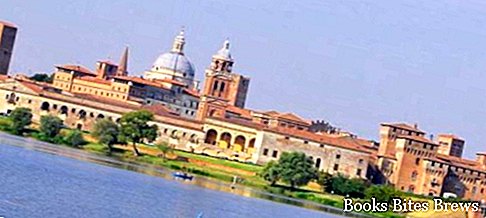What to see in Mantua, one-day itinerary including the main monuments and places of interest, including Palazzo Te, Palazzo Ducale and Basilica of Sant'Andrea.
Tourist information
City of art in Lombardy, around which the Mincio river widens to form three lakes, Mantua was one of the most vital centers of the Renaissance, during which artists such as Donatello, Leon Battista Alberti, Andrea Mantegna, Giulio Romano, as well as excellent artisans invited to the Gonzaga court, created splendid works of art.
Mantua, together with Sabbioneta, is part of the World Heritage Sites declared by UNESCO.
In the sixth century BC the Mantuan territory corresponded to one of the most advanced points of the expansion, towards the north east, of the Etruscan people.
Etruscan rule ended in 388 BC, following the invasion of the Cenomani Gauls.
In 220 BC there was the conquest of the Romans and, near Mantua, in a small village corresponding to today's Pietole, in 70 BC. Publius Virgil Marone was born, a Latin poet and philosopher.
After the fall of the Roman Empire, Mantua was invaded by Goths, Byzantines, Lombards and Franks.
In the mid-ninth century, the territory was subject to the Canossa jurisdiction, at the behest of Emperor Ludwig II.
After the death of Countess Matilde in 1116, the city became a free municipality.
In the municipal era Mantua became a commercially and politically important center, where the Bonacolsi, Arlotti, Casaloldi families established themselves.
In 1272 the Bonacolsi gained dominion of the city, maintaining it until 1328, when the Gonzaga family took power.
Recommended readings- Lombardy: Sunday day trips
- Varese (Lombardy): what to see
- Valcamonica (Lombardy): what to see and rock carvings
- Pavia (Lombardy): what to see
- Lake Iseo (Lombardy): what to see in 1 day
Until 1707 the history of Mantua was linked to this family, having obtained from the emperor Sigismondo the title of marquises and the right to inherit power.
After 1707 Mantua was assigned to Austria, as the last duke of the branch, Gonzaga-Nevers, was ousted by the Germanic emperor, for not having fulfilled his duties of vassalage.
This first phase of Austrian domination, which lasted almost a century, was followed by a period of French domination.
In 1815, after the Congress of Vienna, the Austrians regained possession of the city, until joining the Kingdom of Italy.
Near the Ponte San Giorgio, which divides Lake Mezzo from Lake Inferiore, the most famous historical and artistic places and buildings of the city are concentrated, starting with Piazza Sordello, bordered by some of the most interesting monuments of the city.
Entering from the south side, from the arch that allows access to the nearby Piazza Broletto, Piazza Sordello is closed on the left by a series of ancient embattled buildings of the thirteenth century, which is contrasted on the opposite side by the facade of Palazzo Ducale, while the facade of the Cathedral closes the northern side.
What see
The Duomo, of medieval origin and dedicated to San Pietro, is characterized by different styles, present in various parts of the church, such as the late Gothic side, the sixteenth-century interior, the Romanesque bell tower and the neoclassical facade made of Carrara marble.
The Palazzo Ducale, which was the main residence of the Gonzaga family, consists of a complex of buildings, built between the second half of the twelfth century and the middle of the seventeenth century, which develop towards the shores of Lake Inferiore, including palaces, gardens, churches , internal squares and arcades.
The oldest nucleus of the palace corresponds to the buildings facing Piazza Sordello, which are the Magna Domus and Palazzo del Capitano, built by the Bonacolsi.
The Palace is made up of over five hundred rooms, containing remarkable testimonies relating to the major artists who lent their work in the city.
Very famous is the Camera Picta, better known as the "wedding room", frescoed by Mantegna and located in the north-east tower of the Castle of San Giorgio, also part of the Palazzo Ducale complex.
In Piazza Mantegna there is the Basilica of Sant'Andrea, rebuilt over two previous buildings, relating to a Benedictine monastery and a church dedicated to the apostle Andrea, built where vases containing the relic of the earth were found, imbued with the precious Blood of Christ on the cross.
In 1472 Ludovico II Gonzaga entrusted the design of this prestigious Renaissance work to Leon Battista Alberti, while the works were followed by Luca Fancelli.
The Basilica was completed several times, while the roof was built, with a dome designed by Filippo Juvarra, between 1732 and 1765.
In the Crypt, under the Basilica, sacred vessels containing the Blood of Christ are kept.
In the first chapel, located on the left side, there is the tomb of the painter Andrea Mantegna, who died in Mantua in 1506.
Of the old buildings, the Gothic bell tower and one side of the cloister remain.
In Piazza Erbe, adjacent to Piazza Mantegna, there is the Rotonda di San Loreno, which is the oldest church in Mantua.
The building was built in 1082 by Matilda of Canossa, probably starting from the church of the Holy Sepulcher of Jerusalem, probably built as regards the circular plan, built by Emperor Constantine.
Inside there are traces of frescoes, from the eleventh and twelfth centuries, of Byzantine derivation.
Among the most important buildings in Mantua, Palazzo Te, whose name derives from the ancient one of the town where it was built, is worth a visit.
The palace, with its original architectural layout, was built at the behest of Federico II Gonzaga between 1525 and 1526, based on a design by Giulio Pippi, better known as Giulio Romano.
The large suburban villa, considered an architectural and pictorial masterpiece by Giulio Romano, was built as a building to be dedicated to leisure, receptions and ceremonies.




